Media Psychology Assignment: Media Panic and The Social Dilemma
VerifiedAdded on 2022/03/23
|7
|2171
|94
Essay
AI Summary
This essay critically analyzes the concepts of media panic and the social dilemma, drawing upon the works of Pamela Brown Rutledge and the documentary 'The Social Dilemma'. It explores the historical context of media panics, examining how new technologies like the internet and social media have been met with emotional criticism and concerns about their impact on society. The essay delves into the psychological effects of social media, including its potential for addiction, manipulation of user behavior, and negative impacts on mental health, such as cyberbullying and 'Facebook depression'. It discusses the roles of algorithms and tech companies in shaping user experiences and influencing public opinion. The essay also examines the documentary 'The Social Dilemma', its critique of Silicon Valley's practices, and its implications for understanding the complex relationship between media, technology, and human well-being. The essay concludes by emphasizing the importance of critical thinking and responsible media consumption in navigating the challenges posed by the digital age.
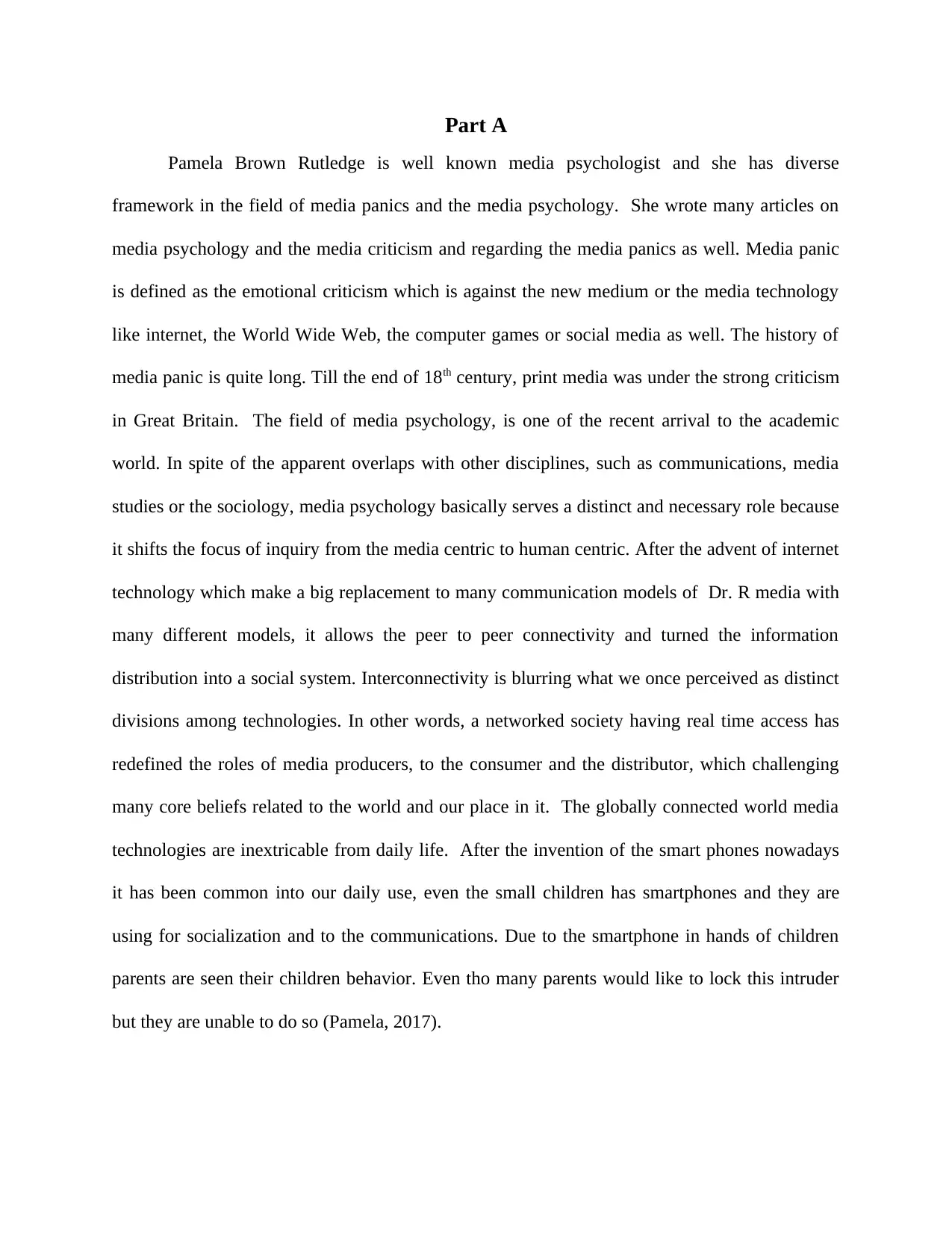
Part A
Pamela Brown Rutledge is well known media psychologist and she has diverse
framework in the field of media panics and the media psychology. She wrote many articles on
media psychology and the media criticism and regarding the media panics as well. Media panic
is defined as the emotional criticism which is against the new medium or the media technology
like internet, the World Wide Web, the computer games or social media as well. The history of
media panic is quite long. Till the end of 18th century, print media was under the strong criticism
in Great Britain. The field of media psychology, is one of the recent arrival to the academic
world. In spite of the apparent overlaps with other disciplines, such as communications, media
studies or the sociology, media psychology basically serves a distinct and necessary role because
it shifts the focus of inquiry from the media centric to human centric. After the advent of internet
technology which make a big replacement to many communication models of Dr. R media with
many different models, it allows the peer to peer connectivity and turned the information
distribution into a social system. Interconnectivity is blurring what we once perceived as distinct
divisions among technologies. In other words, a networked society having real time access has
redefined the roles of media producers, to the consumer and the distributor, which challenging
many core beliefs related to the world and our place in it. The globally connected world media
technologies are inextricable from daily life. After the invention of the smart phones nowadays
it has been common into our daily use, even the small children has smartphones and they are
using for socialization and to the communications. Due to the smartphone in hands of children
parents are seen their children behavior. Even tho many parents would like to lock this intruder
but they are unable to do so (Pamela, 2017).
Pamela Brown Rutledge is well known media psychologist and she has diverse
framework in the field of media panics and the media psychology. She wrote many articles on
media psychology and the media criticism and regarding the media panics as well. Media panic
is defined as the emotional criticism which is against the new medium or the media technology
like internet, the World Wide Web, the computer games or social media as well. The history of
media panic is quite long. Till the end of 18th century, print media was under the strong criticism
in Great Britain. The field of media psychology, is one of the recent arrival to the academic
world. In spite of the apparent overlaps with other disciplines, such as communications, media
studies or the sociology, media psychology basically serves a distinct and necessary role because
it shifts the focus of inquiry from the media centric to human centric. After the advent of internet
technology which make a big replacement to many communication models of Dr. R media with
many different models, it allows the peer to peer connectivity and turned the information
distribution into a social system. Interconnectivity is blurring what we once perceived as distinct
divisions among technologies. In other words, a networked society having real time access has
redefined the roles of media producers, to the consumer and the distributor, which challenging
many core beliefs related to the world and our place in it. The globally connected world media
technologies are inextricable from daily life. After the invention of the smart phones nowadays
it has been common into our daily use, even the small children has smartphones and they are
using for socialization and to the communications. Due to the smartphone in hands of children
parents are seen their children behavior. Even tho many parents would like to lock this intruder
but they are unable to do so (Pamela, 2017).
Paraphrase This Document
Need a fresh take? Get an instant paraphrase of this document with our AI Paraphraser
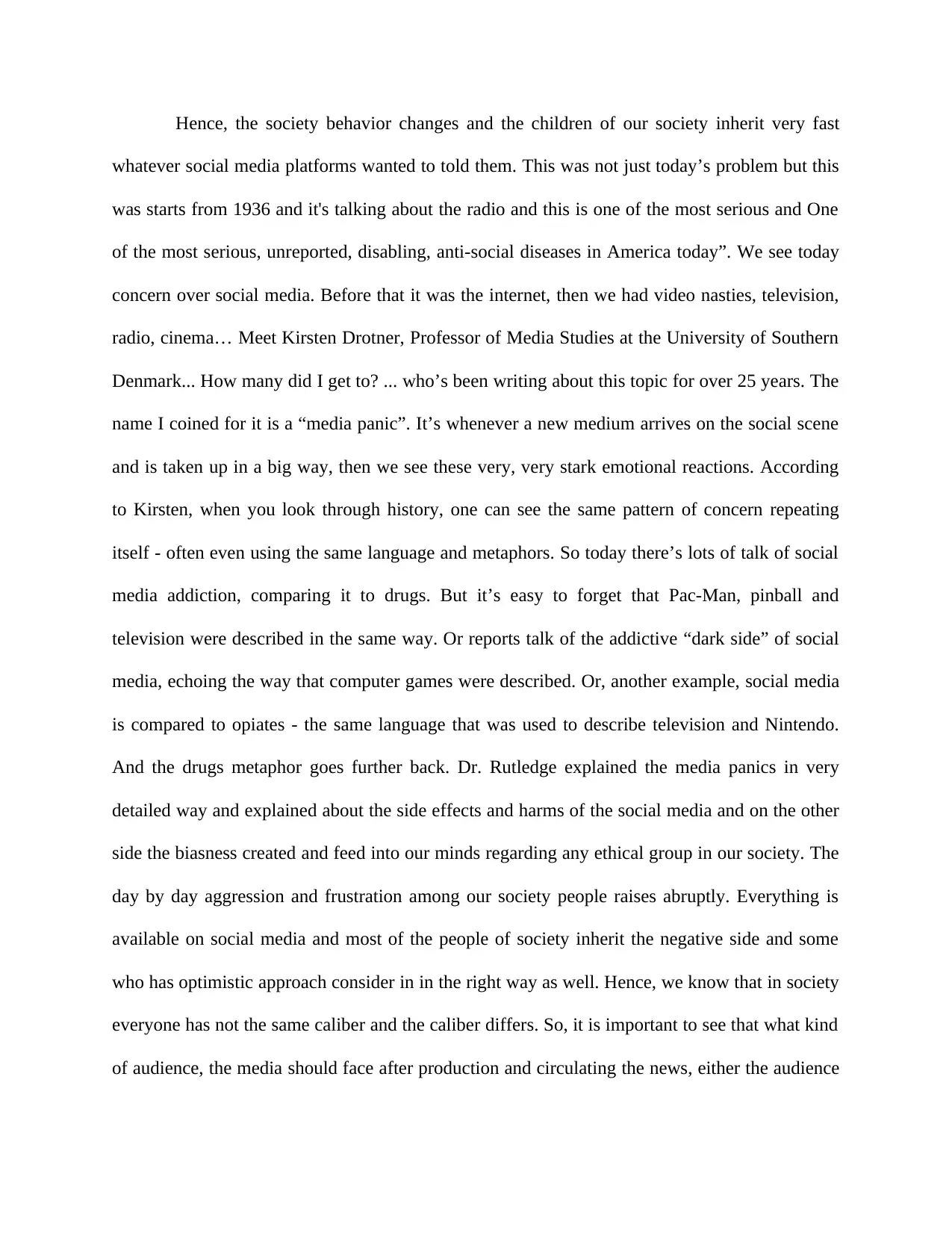
Hence, the society behavior changes and the children of our society inherit very fast
whatever social media platforms wanted to told them. This was not just today’s problem but this
was starts from 1936 and it's talking about the radio and this is one of the most serious and One
of the most serious, unreported, disabling, anti-social diseases in America today”. We see today
concern over social media. Before that it was the internet, then we had video nasties, television,
radio, cinema… Meet Kirsten Drotner, Professor of Media Studies at the University of Southern
Denmark... How many did I get to? ... who’s been writing about this topic for over 25 years. The
name I coined for it is a “media panic”. It’s whenever a new medium arrives on the social scene
and is taken up in a big way, then we see these very, very stark emotional reactions. According
to Kirsten, when you look through history, one can see the same pattern of concern repeating
itself - often even using the same language and metaphors. So today there’s lots of talk of social
media addiction, comparing it to drugs. But it’s easy to forget that Pac-Man, pinball and
television were described in the same way. Or reports talk of the addictive “dark side” of social
media, echoing the way that computer games were described. Or, another example, social media
is compared to opiates - the same language that was used to describe television and Nintendo.
And the drugs metaphor goes further back. Dr. Rutledge explained the media panics in very
detailed way and explained about the side effects and harms of the social media and on the other
side the biasness created and feed into our minds regarding any ethical group in our society. The
day by day aggression and frustration among our society people raises abruptly. Everything is
available on social media and most of the people of society inherit the negative side and some
who has optimistic approach consider in in the right way as well. Hence, we know that in society
everyone has not the same caliber and the caliber differs. So, it is important to see that what kind
of audience, the media should face after production and circulating the news, either the audience
whatever social media platforms wanted to told them. This was not just today’s problem but this
was starts from 1936 and it's talking about the radio and this is one of the most serious and One
of the most serious, unreported, disabling, anti-social diseases in America today”. We see today
concern over social media. Before that it was the internet, then we had video nasties, television,
radio, cinema… Meet Kirsten Drotner, Professor of Media Studies at the University of Southern
Denmark... How many did I get to? ... who’s been writing about this topic for over 25 years. The
name I coined for it is a “media panic”. It’s whenever a new medium arrives on the social scene
and is taken up in a big way, then we see these very, very stark emotional reactions. According
to Kirsten, when you look through history, one can see the same pattern of concern repeating
itself - often even using the same language and metaphors. So today there’s lots of talk of social
media addiction, comparing it to drugs. But it’s easy to forget that Pac-Man, pinball and
television were described in the same way. Or reports talk of the addictive “dark side” of social
media, echoing the way that computer games were described. Or, another example, social media
is compared to opiates - the same language that was used to describe television and Nintendo.
And the drugs metaphor goes further back. Dr. Rutledge explained the media panics in very
detailed way and explained about the side effects and harms of the social media and on the other
side the biasness created and feed into our minds regarding any ethical group in our society. The
day by day aggression and frustration among our society people raises abruptly. Everything is
available on social media and most of the people of society inherit the negative side and some
who has optimistic approach consider in in the right way as well. Hence, we know that in society
everyone has not the same caliber and the caliber differs. So, it is important to see that what kind
of audience, the media should face after production and circulating the news, either the audience
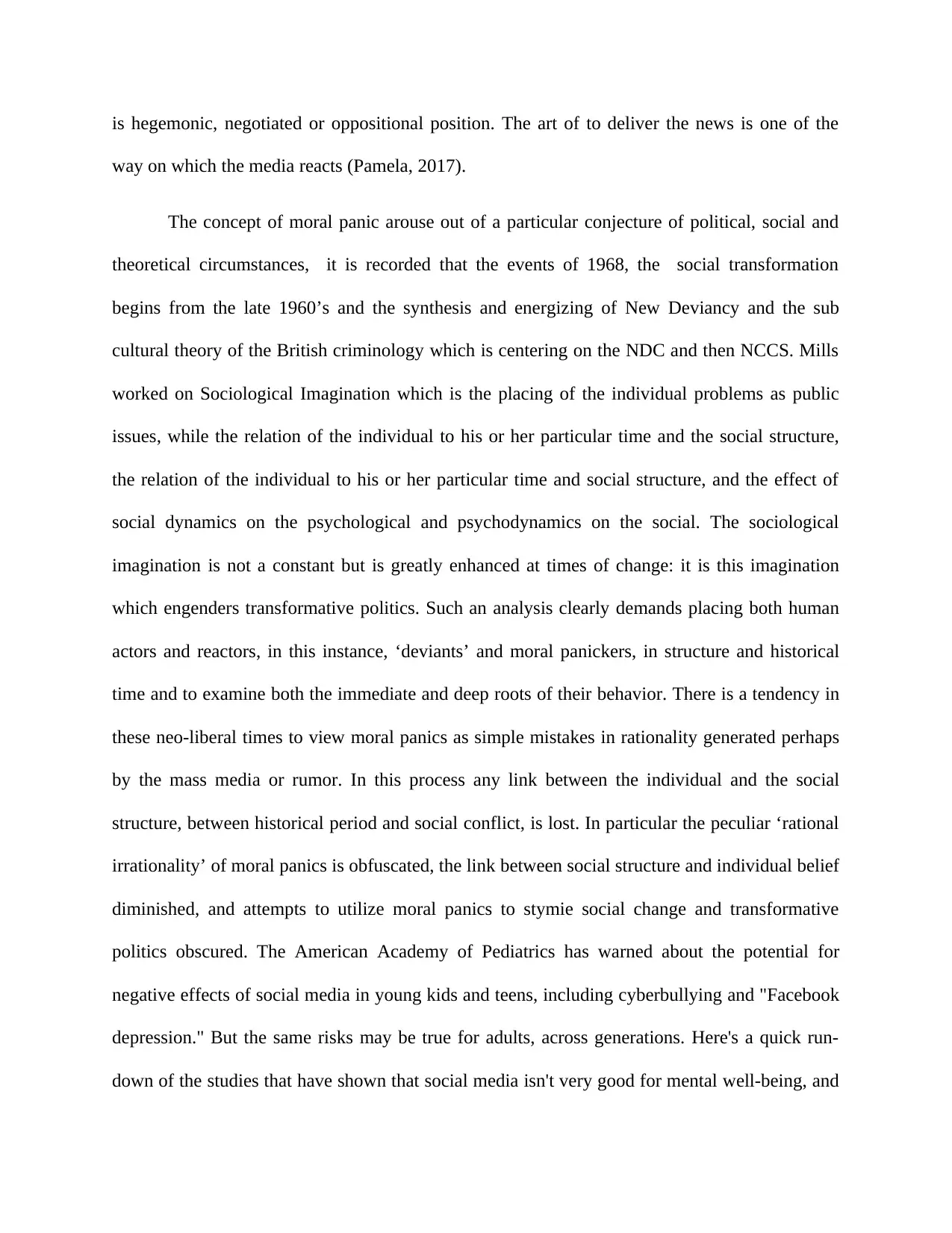
is hegemonic, negotiated or oppositional position. The art of to deliver the news is one of the
way on which the media reacts (Pamela, 2017).
The concept of moral panic arouse out of a particular conjecture of political, social and
theoretical circumstances, it is recorded that the events of 1968, the social transformation
begins from the late 1960’s and the synthesis and energizing of New Deviancy and the sub
cultural theory of the British criminology which is centering on the NDC and then NCCS. Mills
worked on Sociological Imagination which is the placing of the individual problems as public
issues, while the relation of the individual to his or her particular time and the social structure,
the relation of the individual to his or her particular time and social structure, and the effect of
social dynamics on the psychological and psychodynamics on the social. The sociological
imagination is not a constant but is greatly enhanced at times of change: it is this imagination
which engenders transformative politics. Such an analysis clearly demands placing both human
actors and reactors, in this instance, ‘deviants’ and moral panickers, in structure and historical
time and to examine both the immediate and deep roots of their behavior. There is a tendency in
these neo-liberal times to view moral panics as simple mistakes in rationality generated perhaps
by the mass media or rumor. In this process any link between the individual and the social
structure, between historical period and social conflict, is lost. In particular the peculiar ‘rational
irrationality’ of moral panics is obfuscated, the link between social structure and individual belief
diminished, and attempts to utilize moral panics to stymie social change and transformative
politics obscured. The American Academy of Pediatrics has warned about the potential for
negative effects of social media in young kids and teens, including cyberbullying and "Facebook
depression." But the same risks may be true for adults, across generations. Here's a quick run-
down of the studies that have shown that social media isn't very good for mental well-being, and
way on which the media reacts (Pamela, 2017).
The concept of moral panic arouse out of a particular conjecture of political, social and
theoretical circumstances, it is recorded that the events of 1968, the social transformation
begins from the late 1960’s and the synthesis and energizing of New Deviancy and the sub
cultural theory of the British criminology which is centering on the NDC and then NCCS. Mills
worked on Sociological Imagination which is the placing of the individual problems as public
issues, while the relation of the individual to his or her particular time and the social structure,
the relation of the individual to his or her particular time and social structure, and the effect of
social dynamics on the psychological and psychodynamics on the social. The sociological
imagination is not a constant but is greatly enhanced at times of change: it is this imagination
which engenders transformative politics. Such an analysis clearly demands placing both human
actors and reactors, in this instance, ‘deviants’ and moral panickers, in structure and historical
time and to examine both the immediate and deep roots of their behavior. There is a tendency in
these neo-liberal times to view moral panics as simple mistakes in rationality generated perhaps
by the mass media or rumor. In this process any link between the individual and the social
structure, between historical period and social conflict, is lost. In particular the peculiar ‘rational
irrationality’ of moral panics is obfuscated, the link between social structure and individual belief
diminished, and attempts to utilize moral panics to stymie social change and transformative
politics obscured. The American Academy of Pediatrics has warned about the potential for
negative effects of social media in young kids and teens, including cyberbullying and "Facebook
depression." But the same risks may be true for adults, across generations. Here's a quick run-
down of the studies that have shown that social media isn't very good for mental well-being, and
⊘ This is a preview!⊘
Do you want full access?
Subscribe today to unlock all pages.

Trusted by 1+ million students worldwide
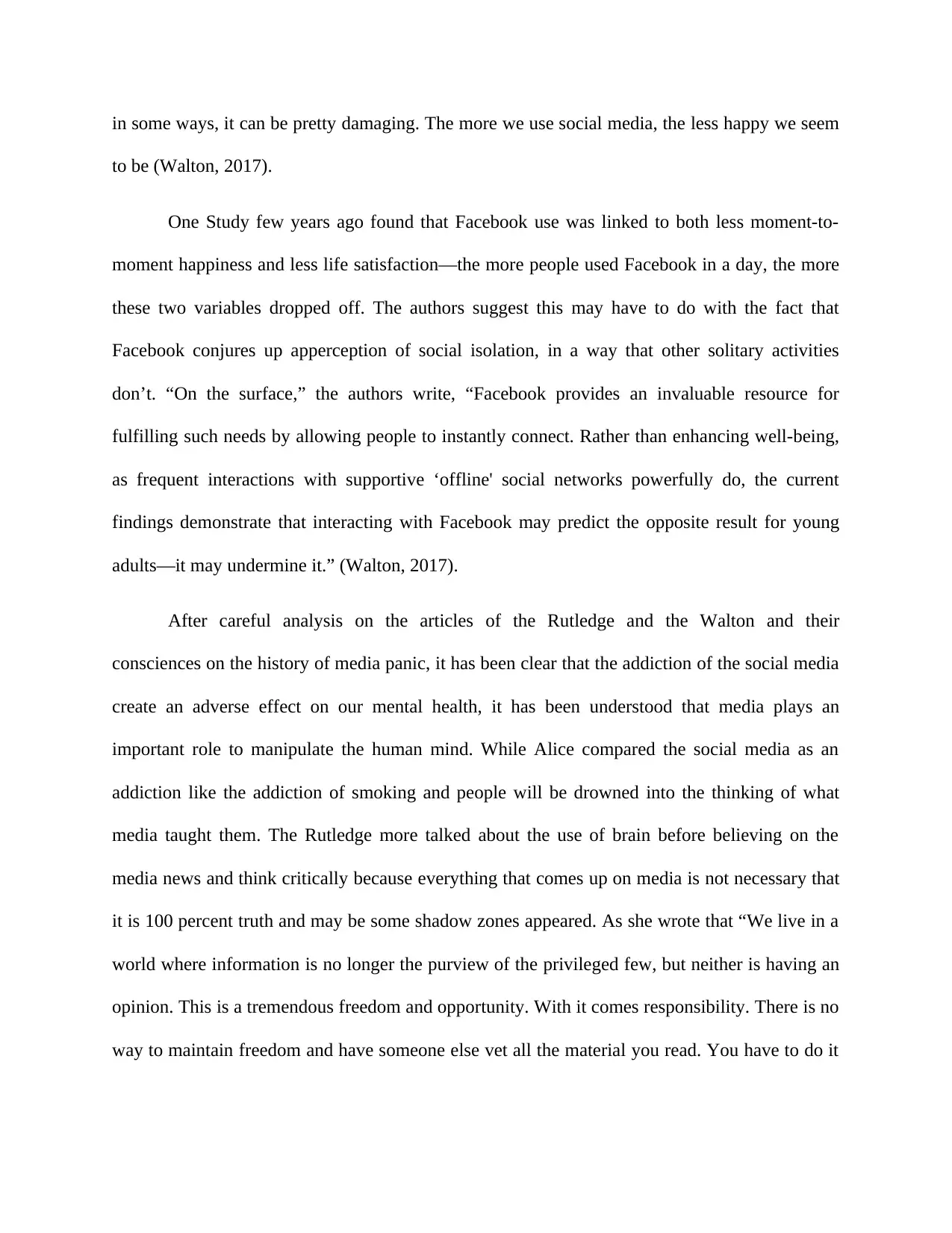
in some ways, it can be pretty damaging. The more we use social media, the less happy we seem
to be (Walton, 2017).
One Study few years ago found that Facebook use was linked to both less moment-to-
moment happiness and less life satisfaction—the more people used Facebook in a day, the more
these two variables dropped off. The authors suggest this may have to do with the fact that
Facebook conjures up apperception of social isolation, in a way that other solitary activities
don’t. “On the surface,” the authors write, “Facebook provides an invaluable resource for
fulfilling such needs by allowing people to instantly connect. Rather than enhancing well-being,
as frequent interactions with supportive ‘offline' social networks powerfully do, the current
findings demonstrate that interacting with Facebook may predict the opposite result for young
adults—it may undermine it.” (Walton, 2017).
After careful analysis on the articles of the Rutledge and the Walton and their
consciences on the history of media panic, it has been clear that the addiction of the social media
create an adverse effect on our mental health, it has been understood that media plays an
important role to manipulate the human mind. While Alice compared the social media as an
addiction like the addiction of smoking and people will be drowned into the thinking of what
media taught them. The Rutledge more talked about the use of brain before believing on the
media news and think critically because everything that comes up on media is not necessary that
it is 100 percent truth and may be some shadow zones appeared. As she wrote that “We live in a
world where information is no longer the purview of the privileged few, but neither is having an
opinion. This is a tremendous freedom and opportunity. With it comes responsibility. There is no
way to maintain freedom and have someone else vet all the material you read. You have to do it
to be (Walton, 2017).
One Study few years ago found that Facebook use was linked to both less moment-to-
moment happiness and less life satisfaction—the more people used Facebook in a day, the more
these two variables dropped off. The authors suggest this may have to do with the fact that
Facebook conjures up apperception of social isolation, in a way that other solitary activities
don’t. “On the surface,” the authors write, “Facebook provides an invaluable resource for
fulfilling such needs by allowing people to instantly connect. Rather than enhancing well-being,
as frequent interactions with supportive ‘offline' social networks powerfully do, the current
findings demonstrate that interacting with Facebook may predict the opposite result for young
adults—it may undermine it.” (Walton, 2017).
After careful analysis on the articles of the Rutledge and the Walton and their
consciences on the history of media panic, it has been clear that the addiction of the social media
create an adverse effect on our mental health, it has been understood that media plays an
important role to manipulate the human mind. While Alice compared the social media as an
addiction like the addiction of smoking and people will be drowned into the thinking of what
media taught them. The Rutledge more talked about the use of brain before believing on the
media news and think critically because everything that comes up on media is not necessary that
it is 100 percent truth and may be some shadow zones appeared. As she wrote that “We live in a
world where information is no longer the purview of the privileged few, but neither is having an
opinion. This is a tremendous freedom and opportunity. With it comes responsibility. There is no
way to maintain freedom and have someone else vet all the material you read. You have to do it
Paraphrase This Document
Need a fresh take? Get an instant paraphrase of this document with our AI Paraphraser
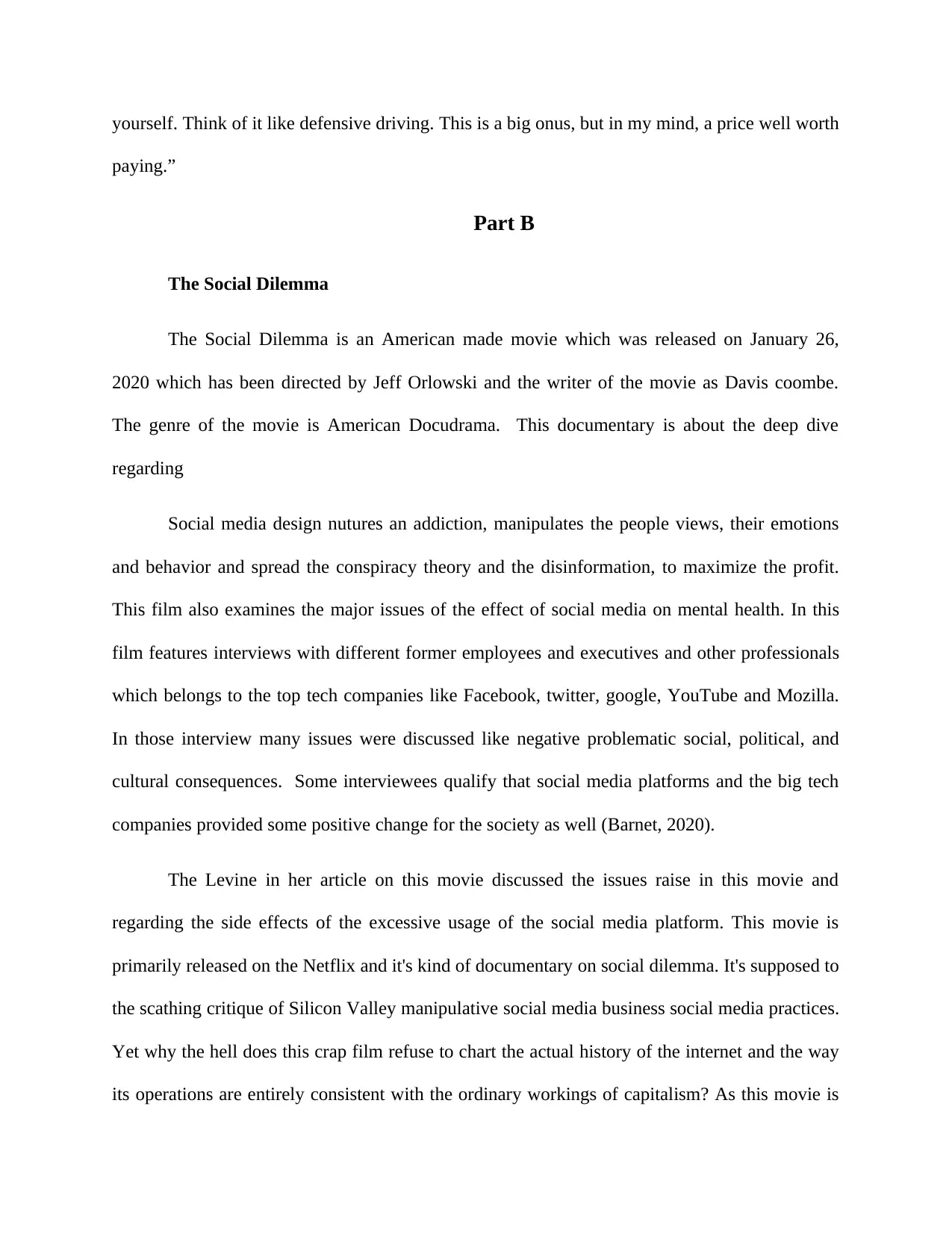
yourself. Think of it like defensive driving. This is a big onus, but in my mind, a price well worth
paying.”
Part B
The Social Dilemma
The Social Dilemma is an American made movie which was released on January 26,
2020 which has been directed by Jeff Orlowski and the writer of the movie as Davis coombe.
The genre of the movie is American Docudrama. This documentary is about the deep dive
regarding
Social media design nutures an addiction, manipulates the people views, their emotions
and behavior and spread the conspiracy theory and the disinformation, to maximize the profit.
This film also examines the major issues of the effect of social media on mental health. In this
film features interviews with different former employees and executives and other professionals
which belongs to the top tech companies like Facebook, twitter, google, YouTube and Mozilla.
In those interview many issues were discussed like negative problematic social, political, and
cultural consequences. Some interviewees qualify that social media platforms and the big tech
companies provided some positive change for the society as well (Barnet, 2020).
The Levine in her article on this movie discussed the issues raise in this movie and
regarding the side effects of the excessive usage of the social media platform. This movie is
primarily released on the Netflix and it's kind of documentary on social dilemma. It's supposed to
the scathing critique of Silicon Valley manipulative social media business social media practices.
Yet why the hell does this crap film refuse to chart the actual history of the internet and the way
its operations are entirely consistent with the ordinary workings of capitalism? As this movie is
paying.”
Part B
The Social Dilemma
The Social Dilemma is an American made movie which was released on January 26,
2020 which has been directed by Jeff Orlowski and the writer of the movie as Davis coombe.
The genre of the movie is American Docudrama. This documentary is about the deep dive
regarding
Social media design nutures an addiction, manipulates the people views, their emotions
and behavior and spread the conspiracy theory and the disinformation, to maximize the profit.
This film also examines the major issues of the effect of social media on mental health. In this
film features interviews with different former employees and executives and other professionals
which belongs to the top tech companies like Facebook, twitter, google, YouTube and Mozilla.
In those interview many issues were discussed like negative problematic social, political, and
cultural consequences. Some interviewees qualify that social media platforms and the big tech
companies provided some positive change for the society as well (Barnet, 2020).
The Levine in her article on this movie discussed the issues raise in this movie and
regarding the side effects of the excessive usage of the social media platform. This movie is
primarily released on the Netflix and it's kind of documentary on social dilemma. It's supposed to
the scathing critique of Silicon Valley manipulative social media business social media practices.
Yet why the hell does this crap film refuse to chart the actual history of the internet and the way
its operations are entirely consistent with the ordinary workings of capitalism? As this movie is
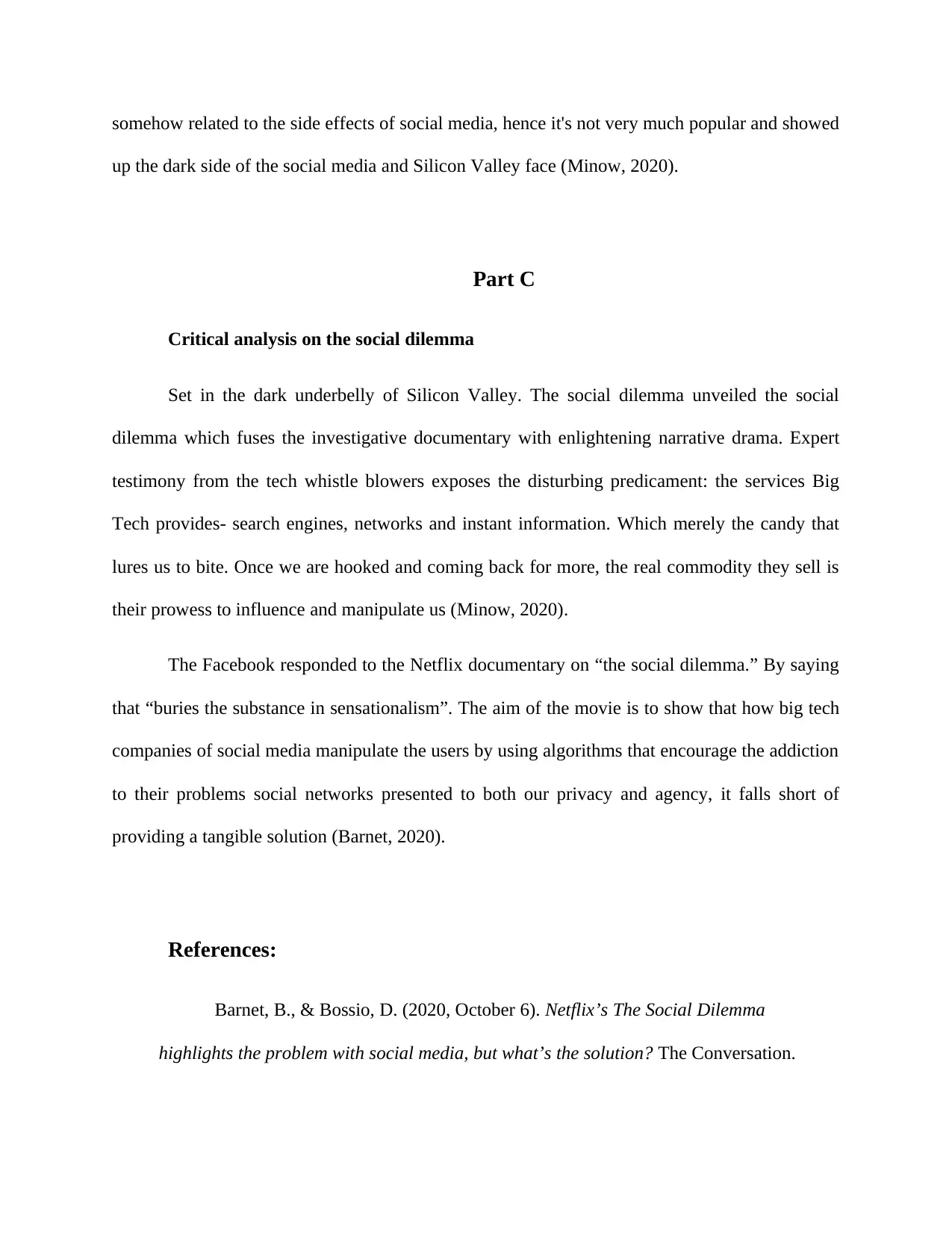
somehow related to the side effects of social media, hence it's not very much popular and showed
up the dark side of the social media and Silicon Valley face (Minow, 2020).
Part C
Critical analysis on the social dilemma
Set in the dark underbelly of Silicon Valley. The social dilemma unveiled the social
dilemma which fuses the investigative documentary with enlightening narrative drama. Expert
testimony from the tech whistle blowers exposes the disturbing predicament: the services Big
Tech provides- search engines, networks and instant information. Which merely the candy that
lures us to bite. Once we are hooked and coming back for more, the real commodity they sell is
their prowess to influence and manipulate us (Minow, 2020).
The Facebook responded to the Netflix documentary on “the social dilemma.” By saying
that “buries the substance in sensationalism”. The aim of the movie is to show that how big tech
companies of social media manipulate the users by using algorithms that encourage the addiction
to their problems social networks presented to both our privacy and agency, it falls short of
providing a tangible solution (Barnet, 2020).
References:
Barnet, B., & Bossio, D. (2020, October 6). Netflix’s The Social Dilemma
highlights the problem with social media, but what’s the solution? The Conversation.
up the dark side of the social media and Silicon Valley face (Minow, 2020).
Part C
Critical analysis on the social dilemma
Set in the dark underbelly of Silicon Valley. The social dilemma unveiled the social
dilemma which fuses the investigative documentary with enlightening narrative drama. Expert
testimony from the tech whistle blowers exposes the disturbing predicament: the services Big
Tech provides- search engines, networks and instant information. Which merely the candy that
lures us to bite. Once we are hooked and coming back for more, the real commodity they sell is
their prowess to influence and manipulate us (Minow, 2020).
The Facebook responded to the Netflix documentary on “the social dilemma.” By saying
that “buries the substance in sensationalism”. The aim of the movie is to show that how big tech
companies of social media manipulate the users by using algorithms that encourage the addiction
to their problems social networks presented to both our privacy and agency, it falls short of
providing a tangible solution (Barnet, 2020).
References:
Barnet, B., & Bossio, D. (2020, October 6). Netflix’s The Social Dilemma
highlights the problem with social media, but what’s the solution? The Conversation.
⊘ This is a preview!⊘
Do you want full access?
Subscribe today to unlock all pages.

Trusted by 1+ million students worldwide
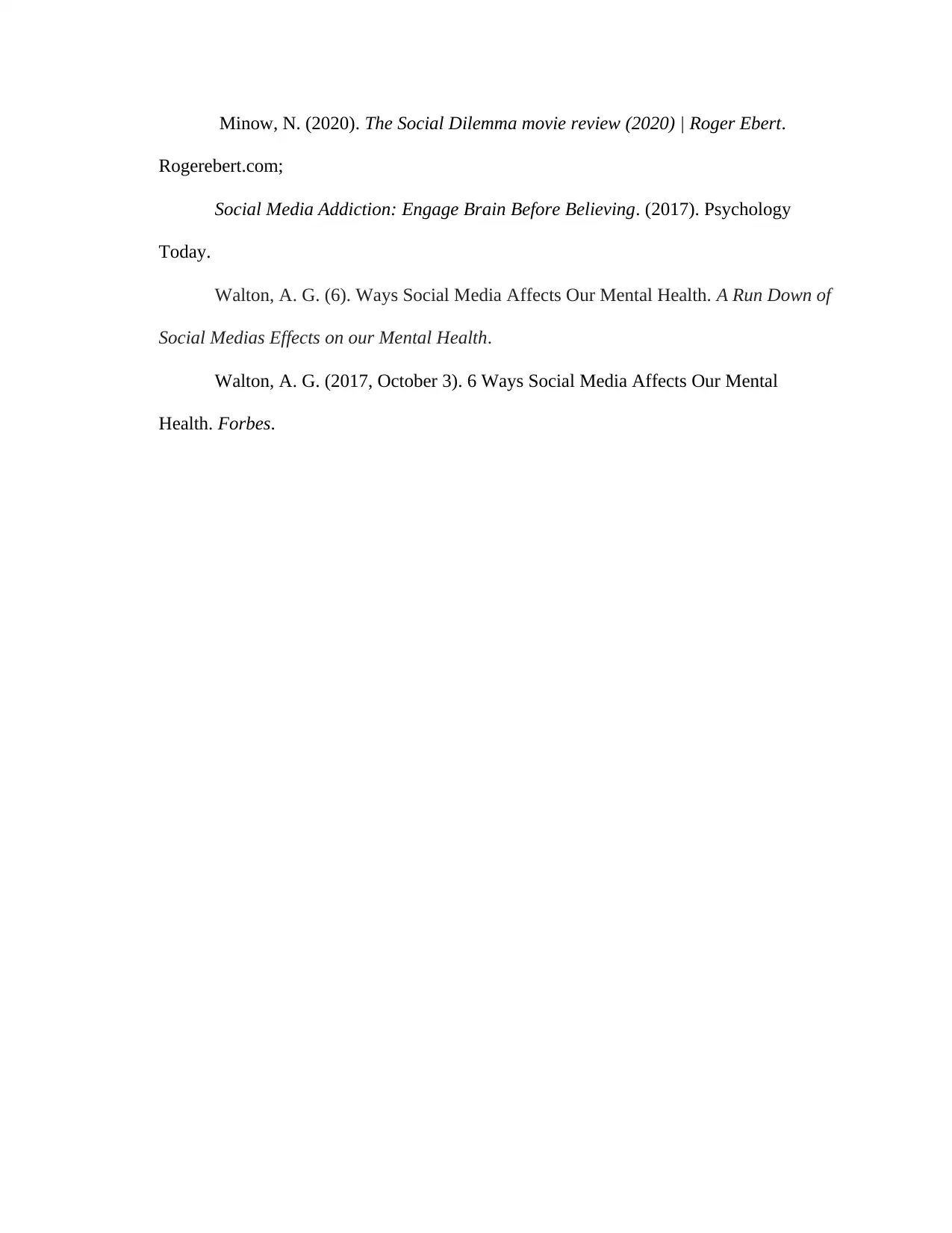
Minow, N. (2020). The Social Dilemma movie review (2020) | Roger Ebert.
Rogerebert.com;
Social Media Addiction: Engage Brain Before Believing. (2017). Psychology
Today.
Walton, A. G. (6). Ways Social Media Affects Our Mental Health. A Run Down of
Social Medias Effects on our Mental Health.
Walton, A. G. (2017, October 3). 6 Ways Social Media Affects Our Mental
Health. Forbes.
Rogerebert.com;
Social Media Addiction: Engage Brain Before Believing. (2017). Psychology
Today.
Walton, A. G. (6). Ways Social Media Affects Our Mental Health. A Run Down of
Social Medias Effects on our Mental Health.
Walton, A. G. (2017, October 3). 6 Ways Social Media Affects Our Mental
Health. Forbes.
1 out of 7
Related Documents
Your All-in-One AI-Powered Toolkit for Academic Success.
+13062052269
info@desklib.com
Available 24*7 on WhatsApp / Email
![[object Object]](/_next/static/media/star-bottom.7253800d.svg)
Unlock your academic potential
Copyright © 2020–2025 A2Z Services. All Rights Reserved. Developed and managed by ZUCOL.




